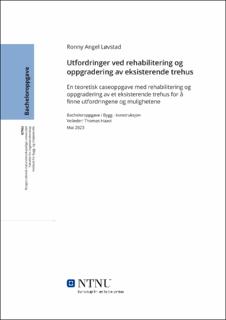| dc.description.abstract | Et eldre trehus ble teoretisk rehabilitert og oppgradert med så mye gjenbruk som mulig. Bakgrunnen er at kommunene kan nå gi unntak fra tekniske krav i regelverket. Dette skal gjøre rehabilitering og oppgradering enklere. Trehuset hadde en kjeller, en første etasje og en halv andre etasje. Taket var et saltak. Hele andre etasje ble endret, og det ble prosjektert pulttak. Bæring i første etasje og kjeller ble gjenbrukt. Det ble undersøkt hvilke utfordringer i prosessen ovenfor kommunen, og i prosjekteringen man kunne støte på. Noen av utfordringene er ukjent kvalitet på materialer i eksisterende konstruksjon, ny overføring av krefter, ukjent tilstand på konstruksjonen før byggestart og dokumentering av at konstruksjonen er i overensstemmelse med tekniske krav. Konklusjonen er at denne renoveringen og oppgraderingen er mulig med dagens regelverk gitt at det gis unntak fra tekniske krav. | |
| dc.description.abstract | The purpose of this thesis is to examine the challenges that may arise when rehabilitating a structure instead of demolishing it. The study focuses on the structural aspects and aims to ensure the safety of the existing structure while exploring the advantages and disadvantages of rehabilitation compared to demolition.
The methodology for this study involved creating a 3D model of the house using computer-aided design (CAD) software. Components that were vulnerable to unfavourable loads were identified and selected for analysis. Structural analysis software was used to determine their load-carrying capacity and identify any necessary adjustments to withstand unfavourable loads. Adjustments were made in the 3D model, and their effects on the structure were re-evaluated using the analysis software to ensure structural integrity.
The original structure had a pitched roof with a fully functional first floor, a secondary room in the basement, and a half-utilized second floor with a knee wall on the end walls. The second floor of the rehabilitated structure is almost entirely new, and no materials from the original walls were reused. The original beam or floor joist between the first and second floor was retained with some modifications for stability and to prevent the effect of tilting and twisting in the joist.
In a bachelor report of whether it is possible to apply for an exemption, it is important to consider the following conditions: the age of the building, its formal conservation status, type, purpose, location, the duration of the measure, and the current technical condition. Factors that may reduce negative consequences if an exemption is granted, as well as benefits gained from the measure, should also be evaluated. In this thesis, the wooden house had no conservation status, was not of a specific type, and was in a residential area. In addition, the current technical condition was unknown. There were several conditions that reduced negative consequences, such as relaxation of requirements for universal design, ventilation, energy sources, and some fire safety requirements for the first floor and basement. The structure meets important safety and health requirements, and by rehabilitating it, environmental requirements are also met. However, there is a challenge in determining the technical condition and being able to consider construction solutions that are acceptable and in line with recognized standards. | |
